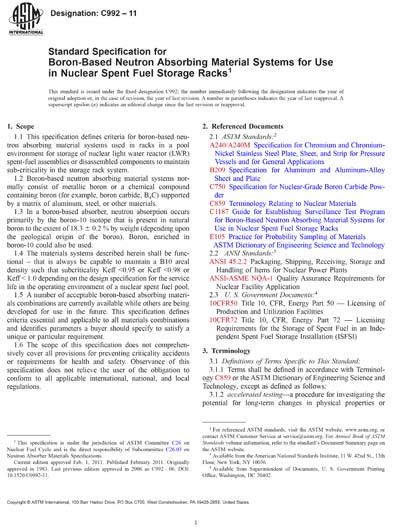Historical
ASTM C992-11
Standard Specification for Boron-Based Neutron Absorbing Material Systems for Use in Nuclear Spent Fuel Storage Racks
1.1 This specification defines criteria for boron-based neutron absorbing material systems used in racks in a pool environment for storage of nuclear light water reactor (LWR) spent-fuel assemblies or disassembled components to maintain sub-criticality in the storage rack system.
1.2 Boron-based neutron absorbing material systems normally consist of metallic boron or a chemical compound containing boron (for example, boron carbide, B4C) supported by a matrix of aluminum, steel, or other materials.
1.3 In a boron-based absorber, neutron absorption occurs primarily by the boron-10 isotope that is present in natural boron to the extent of 18.3 ± 0.2 % by weight (depending upon the geological origin of the boron). Boron, enriched in boron-10 could also be used.
1.4 The materials systems described herein shall be functional – that is always be capable to maintain a B10 areal density such that subcriticality Keff <0.95 or Keff <0.98 or Keff < 1.0 depending on the design specification for the service life in the operating environment of a nuclear spent fuel pool.
1.5 A number of acceptable boron-based absorbing materials combinations are currently available while others are being developed for use in the future. This specification defines criteria essential and applicable to all materials combinations and identifies parameters a buyer should specify to satisfy a unique or particular requirement.
1.6 The scope of this specification does not comprehensively cover all provisions for preventing criticality accidents or requirements for health and safety. Observance of this specification does not relieve the user of the obligation to conform to all applicable international, national, and local regulations.
ASTM International [astm]

